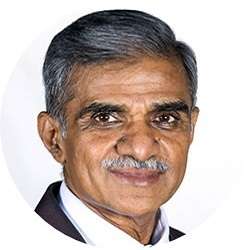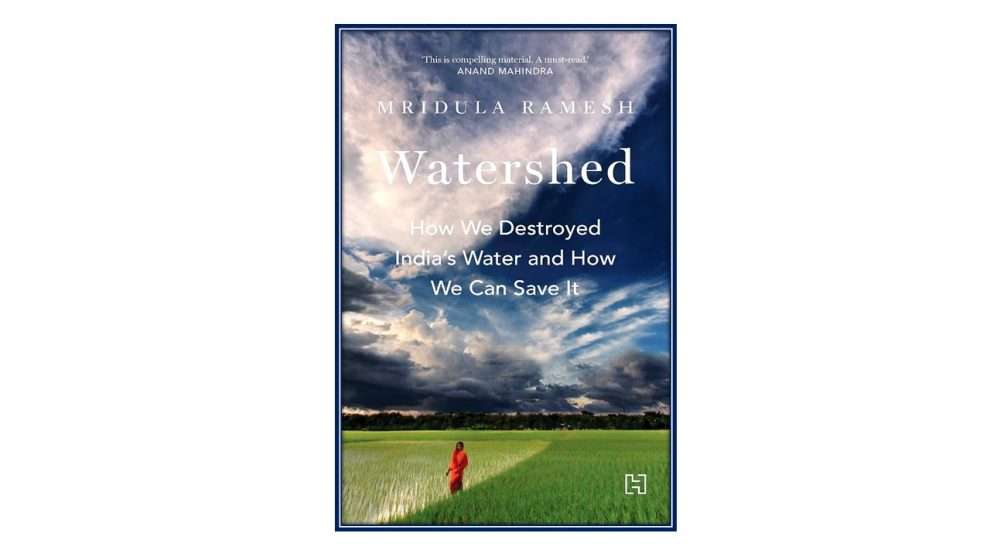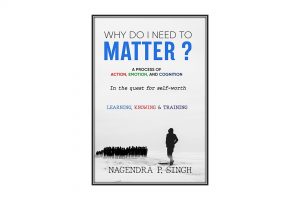Mridula Ramesh (2021)
Hachete, India
Pages: 432
Price: INR ₹ 563.00
ISBN-10 9391028683
With climate change looming large, the thought of a Zero-Water-Day sends fear down the spine of every water-conscious individual. Countries like India that depend heavily on rains for meeting their water requirement will face the worst crisis, and it is feared that by 2030 half the people in India will not be able to meet their water requirements. Day-Zero, as the earth heats up, will bring much trouble with it. In some parts of the globe, large swathes of land will go underwater, whereas elsewhere there will be droughts and famines threatening the livelihoods of a large number of people living on the margins of society. With this as the backdrop, Mridula Ramesh’s book Watershed: How we destroyed India’s water and how we can save it examines the relationship between water and civilization in the Indian sub-continent. She draws a vivid picture of the history of India’s civilization that was shaped around water with anecdotes of how communities treasured water resources while devising their own ingenious ways of storage and conservation.
The title ‘Watershed….’ may be a misleading one to those who would expect a pedagogical approach to the subject, as this book tries to cover the whole gamut of water in its historical, socioeconomic, technological and political contexts. Apart from this the presentation does not adopt the typical ‘academic’ style but an interesting style of narration using anecdotes that are interwoven with data to support the author’s compelling arguments. Mridula Ramesh visits the driest parts of Western India as well as the wettest part on the Northeastern side, and brings out interesting cases that can hold the attention of academicians and policy makers alike. The book is divided into two parts. The first part is devoted to ‘Understanding’ the issues surrounding water and the second to ‘Action’.
Besides tracing the history of water from the time when it was revered as the source of life to a more recent attitude of disrespect and disregard for this precious resource, Ramesh also recounts how the British rule in India marked the beginning of change in the relationship Indians had with water. Once the strong community-based institutions that managed the demand for water weakened and disappeared the dependence of communities on those who ruled increased. This led to the degeneration and neglect of many pristine water bodies, especially in the southern part of the country. Unfortunately, the apathy continues, she laments. She also delves deep into the technologies that are seen more as exploitative rather than ameliorative. In the context of water crisis, for instance, borewells coupled with a free power supply policy that many state governments promote has led to an alarming situation as far as dependence on groundwater for agriculture is concerned. The divide between the rich and poor has had its own consequences especially with regard to how water is perceived by the people living on opposite sides of the divide. While for the rich, water is just a commodity, which is purchased and (mis)used, for the poor, their life revolves around it. The urban poor, especially those living on the fringes of mega-cities, spend their entire day waiting for the water supply to come in tankers. And as it comes, they are not sure if they would get enough and when their next supply would turn up.
The unconventional approach to dealing with a vibrant subject like water does not take away the rigor of the data gathered, its analysis and interpretation. One does not get the feeling that one is reading a subject as serious as water due to the innovative method of narration used. In other words, the author’s articulation is poetic and enticing, which at the same time compels the reader to keep reading. She has put in considerable effort in making the reader understand the monsoon, which is the lifeline of the sub-continent. Vividly captured through data, its variability – both spatial and temporal – is well-depicted. She dwells upon the Green Revolution, which owed its success to over dependence on irrigation, and neglect of the policies required for the other half, namely the drylands. She also talks about how over emphasis on staples such as rice and wheat together with the neglect of millets has caused a crisis, which has led to unrelenting exploitation of groundwater, degradation of soil resources, leading to damaging impact on the health of the nation.
Deforestation in the catchment areas of the rivers, coupled with mining, encroachments and inappropriate land use have played havoc on the riverine system as apparent by the truncated flow of many rivers, especially in South India. Ramesh has also dealt in detail with the policy fault-lines in the management of water demand in the urban population. This has given rise to what is called a ‘water mafia’ that supplies water to desperate urban families that can afford to pay an exorbitant price. She has rightly laid emphasis on the metrics of water and said that what cannot be measured cannot be managed. She laments the poor data management by different government agencies, which she says, is one of the reasons for poor policy formulation. According to her policy planning still uses data projected by the National Commission on Integrated Water Resources Development (NCIWRDP) that is three-decades-old and seriously outdated!
The second part of the book ‘Action’ provides deeper insights into the realm of current invasive technology and the earlier conservation technologies. Modern technologies are data-hungry. The more accurate the data the better the predictive technologies. However, water data is not easy to come by. Over a dozen different departments in government deal with water resources and nearly 20 programs address the subject through a number of different schemes, often with little or no convergence. Getting data for any predictive modeling is a herculean task. Even the largest employment generation project – MNREGS – spends about 40 percent of its funds on water-related works. However, it is not often measured in terms of water storage created, or water harvested, but on the number of ‘man days’ generated.
She also deals with the role of forests in stabilizing water demand and discusses how this role is undervalued in fighting climate change owing to the archaic forest management policies. Tanks, the lifeline of agriculture in South India, fell from grace due to apathy and lack of community initiative leading to unsustainable ways of meeting drinking water demand of large cities by conveying water from rivers located hundreds of kilometers away. This doesn’t make either economic or ecological sense. However, politics has been sustaining such initiatives.
Coming to India’s efforts in reusing water, the daily sewage generation far exceeds its capacity to treat wastewater. However, recent work on new approaches such as decentralized wastewater treatment (DWATS), through constructed wetlands could also have been discussed in this section. Technologies, such as large dams and borewells, she says, have damaged enough of our water resources and goes on to suggest the need for massive afforestation, rejuvenation of water bodies for storing rainwater, and large-scale sewage and waste-water treatment for reusing water – as immediate actions to be taken so as to reverse this crisis. Furthermore, she strongly recommends pricing of water to support water resources development and distribution while promoting incentives and disincentives for prudent water use. Finally, for practitioners she provides a useful checklist of actions that can be taken up at individual households, organizations, and government levels.
In all, the book provides a panoramic view of the water paradigm for India by providing adequate evidence, research data, and well-argued reasons. The chapters are well-organized and have provocative titles teasing the reader to go deeper into each of them. Despite this, one might argue that Mridula Ramesh could have been a little more economical in her narration leading to a much more concise output. Commentary on Public Irrigation System, nation-wide watershed development program and its critique, could have been attempted in detail. However, she offers a lot for policymakers, academics and civil society, as well as individuals who are interested in India’s water management issues.
A few words now on the relevance of this book to extension professionals, particularly to those engaged in the area of natural resource management. It is particularly helpful for an in-depth understanding of issues related to water. A keen understanding of the underlying currents (in water), helps professionals to contextualize community engagement and drive their efforts towards sustainable solutions. The book offers a range of examples and anecdotes from across different agro-ecologies of the country. This is particularly useful to NRM personnel, especially while connecting their work to prevailing community practices, and navigating themselves and the communities they work with through a nuanced path.
 Dr Sreenath Dixit, Interim Global Research Program Director – Resilient Farm & Food Systems, International Crops Research Institute for the Semi-Arid Tropics (ICRISAT), Patancheru, Telangana 502324. Email: D.Sreenath@cgiar.org
Dr Sreenath Dixit, Interim Global Research Program Director – Resilient Farm & Food Systems, International Crops Research Institute for the Semi-Arid Tropics (ICRISAT), Patancheru, Telangana 502324. Email: D.Sreenath@cgiar.org





Dr.Srinath Dixit, has done an excellent job of reviewing and showcasing an interesting very useful, brilliantly researched Book using authenticated time series-cross section available data with insightful analysis, articulations and arguments on Indian Water Paradigm: Past, Present and Future written by Mridula Ramesh. The review provides an intimate touch as if we are reading the Book itself with intensity and extensity of the problem/issues and urgency of action to save the planet from waiting disaster. The readers are natural to get tempted to read the book, understand the real issues, suggested actions to prevent the catastrophe. I humbly salute Mridula Ramesh for writing the timely Book on Indian Water Panorama and Dr.Srinath for an excellent review of the Book.